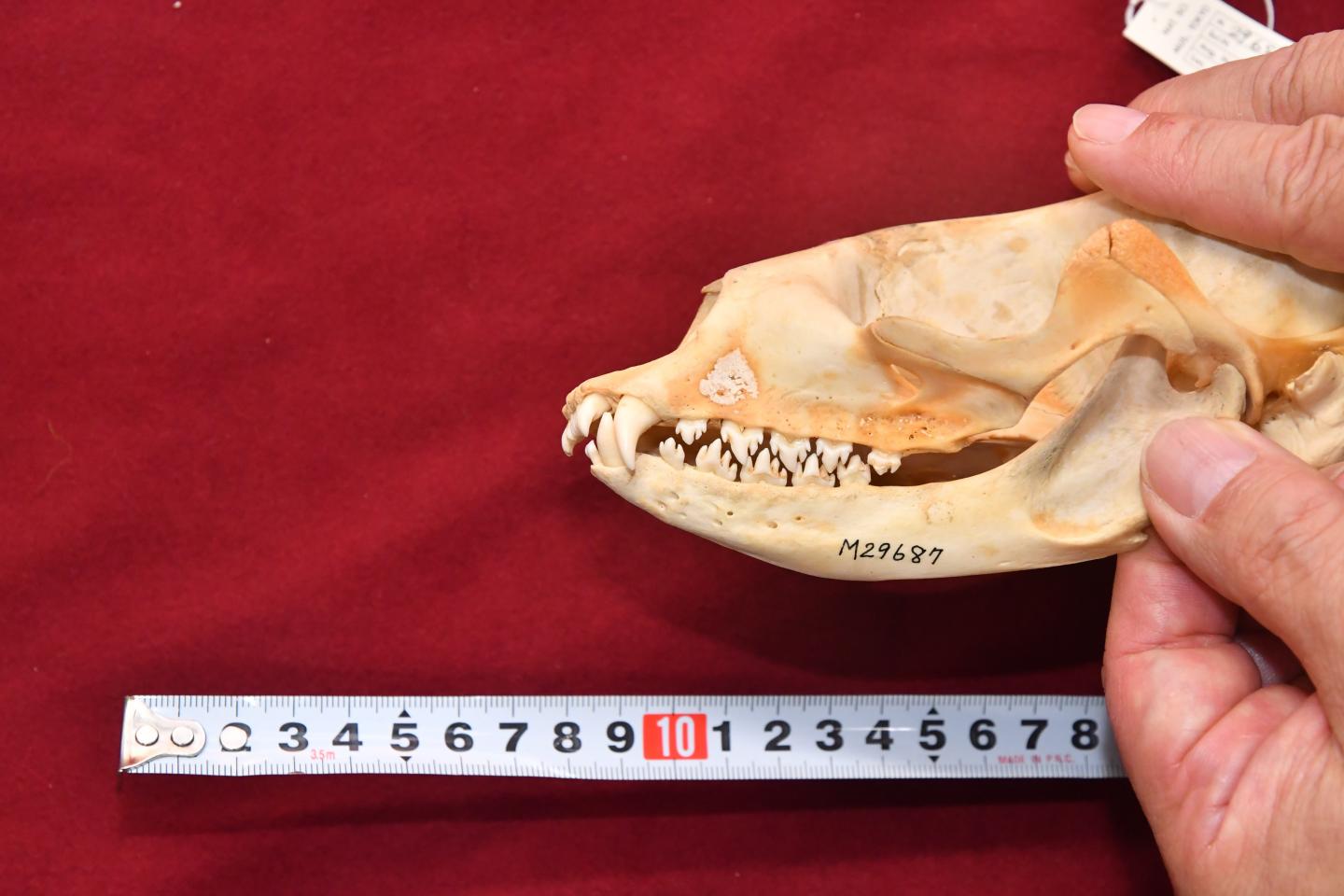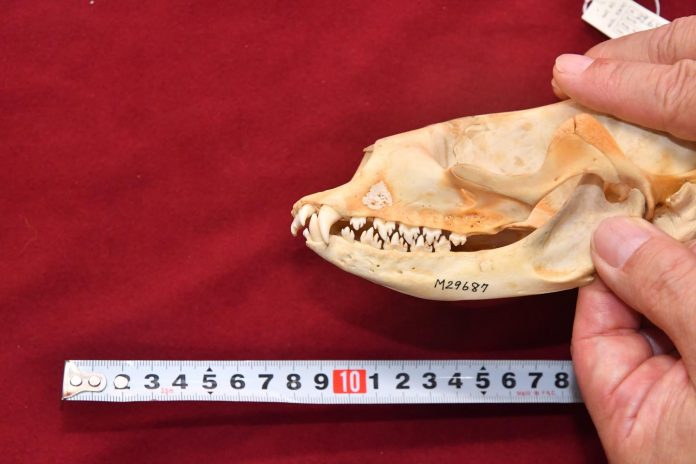
Photo: Skull and jaw demonstrating the highly specialized, comb-like teeth of the Baikal seal that allow them to expel water while retaining prey during high-speed hunting. This together with their small…
view more
Credit Image: NIPR
Through video tracking and examination of museum specimens, scientists have discovered why Siberia’s Lake Baikal seals are thriving when so many other seal populations are suffering from human-caused environmental stresses.
Lake Baikal is the largest and deepest freshwater lake in the world, containing more water than all of North America’s Great Lakes combined. Native only to the lake whose name it bears, the Baikal seal is the only exclusively freshwater seal in the world.
Baikal seals are thriving in this location even as populations of many seals elsewhere have been hit by anthropogenic stresses. It appears to quite like chomping on amphipods, extremely tiny crustaceans typically under 10mm long. These are so small that in terms of the energy gained from eating them, it really should not be worth the hassle of hunting them individually. Yet Lake Baikal seals do precisely this, a rare behaviour for seals or toothed whales anywhere else.
It turns out they have highly specialized comb-line teeth that allow them to expel water while retaining prey during high-speed hunting. Their small size, compared to most other seals, also allows them to achieve a net energy gain from these crustaceans that no other aquatic mammals are terribly keen to eat, according to a study published November 16, 2020 in Proceedings of the National Academy of Sciences (PNAS).
While researchers until now had thought Baikal seals primarily stuck to fish, past investigations of stomach contents have shown that Lake Baikal seals also feed on the amphipod Macrohectopus branickii, the world’s only freshwater amphipod with a planktonic (floating) lifestyle. But the plankton’s tiny size (only a few centimeters long and weighing less than 0.1gram) and the fact that all of its body parts are digestible made it challenging to ascertain just how much plankton these seals ate – and how such tiny prey sustains the seal.
Using animal-borne accelerometers and video cameras, Yuuki Watanabe, a marine biologist with Japan’s National Institute of Polar Research, and colleagues recorded Baikal seals’ foraging behavior, and found that contrary to the prevailing view that they mainly eat fish, the seals actually hunted the amphipod at extremely high rates.
On average, Baikal seals caught 57 amphipods per dive – not all at once, but hunting them individually, leading to thousands of amphipod catches per day. This represents the highest consumption rate ever recorded of any aquatic mammal that feeds on single prey one at a time rather than scooping up lots of different types of prey all at once. In one case, the research team observed a seal hunting down 154 individual amphipods, meaning that it hunted one every 2.5 seconds.
Everywhere else in the world, amphipods are rarely targeted by aquatic mammals, except for a few baleen whales which are able to do so using baleen, which acts as a great big filter to collect krill, plankton and small fish. But hunting these tiny crustaceans individually would have made gaining an energy surplus almost impossible. Swallowing prey and water together requires extra muscular activity, adding to the energy expenditure, and in turn slowing down foraging rates, further reducing the energy profit.
“Each time the seals open their mouth to try to catch an amphipod, there is this huge drawback,” said Watanabe, the paper’s first author. “Water is inevitably going to be swallowed too.”
To answer this question, the team examined museum specimens of the seal, and found that Baikal seals have the most specialized comb-like post-canine teeth in the subfamily Phocinae (Northern seals). This unique feature allows them to expel water while retaining prey during high-speed foraging.
The small body size of the Baikal seals also plays a role in making individual hunting of tiny amphipods energetically rational. Weighing in at around 50 kilograms, they are some of the smallest seals in the world. The researchers modeled the relationship of predator body size, prey body size, and the number of prey a predator needs to consume per dive to replenish the energy expended during the dive. As predator body mass increases, the number of prey needed to be caught per dive increases rapidly. But the Baikal seal size hits the sweet spot where there is a substantial energy profit.
The final piece of the puzzle of the Baikal seal’s unique prey choice, and why it hasn’t been threatened by human-caused environmental changes lies in where it lives: Lake Baikal produces very little algae but is abundant in amphipods.
“This apparent paradox can at least partly be resolved by our finding that the seals eat the amphipods instead of just eating the fish that eat the amphipods,” said Watanabe.
When an organism from a lower trophic level, or food chain, is consumed by one at a higher level, there is a certain loss of energy. “When the seals eat the prey of the fish directly, they are basically shortcutting this chain, and thus avoiding that energy loss.”
The researchers conclude that this evolutionary innovation gives the ecosystem a greater capacity to support apex predators than would otherwise be the case, even given significant levels of human disturbance.
###
About National Institute of Polar Research (NIPR)
The NIPR engages in comprehensive research via observation stations in Arctic and Antarctica. As a member of the Research Organization of Information and Systems (ROIS), the NIPR provides researchers throughout Japan with infrastructure support for Arctic and Antarctic observations, plans and implements Japan’s Antarctic observation projects, and conducts Arctic researches of various scientific fields such as the atmosphere, ice sheets, the ecosystem, the upper atmosphere, the aurora and the Earth’s magnetic field. In addition to the research projects, the NIPR also organizes the Japanese Antarctic Research Expedition and manages samples and data obtained during such expeditions and projects. As a core institution in researches of the polar regions, the NIPR also offers graduate students with a global perspective on originality through its doctoral program. For more information about the NIPR, please visit: https:/
About the Research Organization of Information and Systems (ROIS)
The Research Organization of Information and Systems (ROIS) is a parent organization of four national institutes (National Institute of Polar Research, National Institute of Informatics, the Institute of Statistical Mathematics and National Institute of Genetics) and the Joint Support-Center for Data Science Research. It is ROIS’s mission to promote integrated, cutting-edge research that goes beyond the barriers of these institutions, in addition to facilitating their research activities, as members of inter-university research institutes.
TDnews (tunisiesoir.com)















